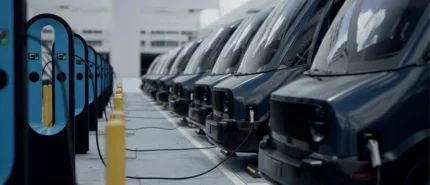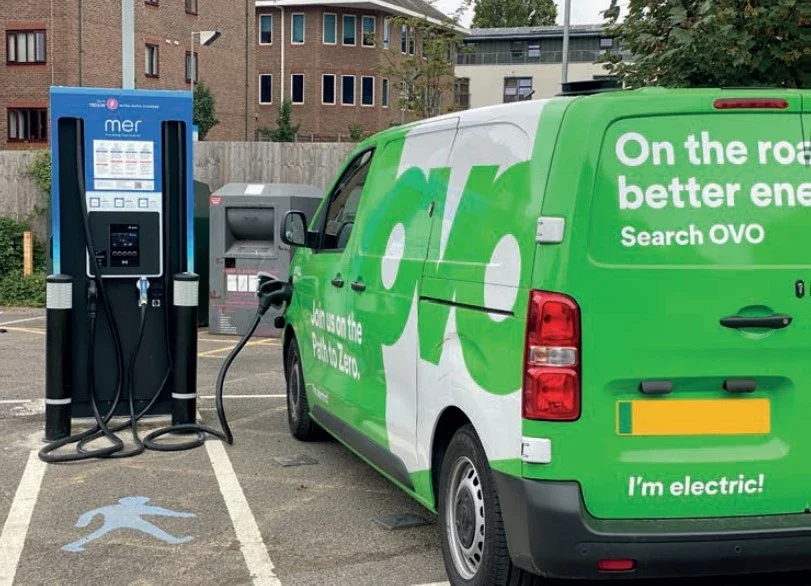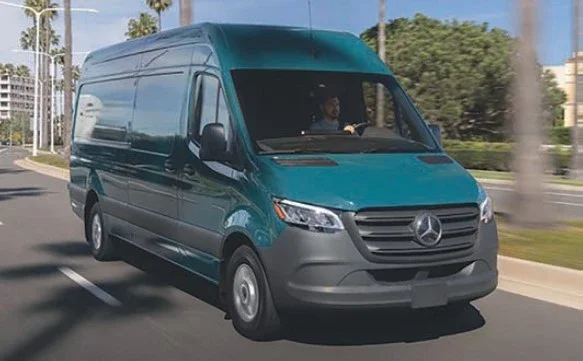
Despite tough economic conditions and the complexities of transitioning to electric power, optimism is not in short supply among UK LCV operators, according to the latest Arval Mobility Observatory (AMO) research, published in May. AMO is widely recognised as one of the authoritative research and industry information exchange platforms in the fleet and mobility sector.
The research, reports James Dallas, editor of What Van?, which covers businesses ranging from those with fewer than 10 employees to those with workforces at least 1,000 strong, found four out of 10 UK companies overall expect to grow their LCV fleets over the next three years, compared to just 26% overall in the European Union (EU). On the other hand, more UK businesses (14%) expect their fleet sizes to decline over the period than their EU counterparts (9%), with those with fewer than 10 employees the most pessimistic. Additionally, almost a third more EU than UK businesses expect fleet sizes to remain stable.
In the UK, small to mid-sized companies with fewer than 100 staff were the most optimistic, with half expecting to take on more LCVs.
Shaun Sadlier, head of AMO in the UK, said: “The smallest businesses might be more worried about fleet reduction simply because they are often more directly exposed to market forces and there are some signs of economic headwinds.
“Conversely, 50% of SMEs could be expecting growth based on opportunities that exist for nimble and dynamic companies of that size.”
Sadlier added the biggest reason for expected fleet growth – mentioned by 81% of respondents – was an anticipation of company expansion.
“Needing more vans is very much an indicator of economic optimism,” he said but cautioned that this optimism may not be realistic as it “contrasts with the largely flatlining UK economy”.

When it comes to looking for external advice, the AMO found most operators (58%) seek guidance for legislative and financial matters.
“These are areas where businesses literally cannot afford to make mistakes,” said Sadlier.
“Choosing a non-optimal acquisition method can be very costly, while getting compliance wrong can result in an injury to employees and prosecution resulting in fines and even imprisonment.”
A significant amount (36%) of respondents also sought technical and operational consultancy advice, with the largest businesses most likely to look for help in these areas.
“The numbers jumped up on the technical, operational side,” Sadlier observed.
“The process of electrification is likely to be the key driver here, with many fleets looking at resolving the perceived issues surrounding electric vans, including charging, range and payload,” he said.
When it comes to the costs of running LCVs, fleets of all sizes expect increases across the board over the next year, with most predicting hikes in service, maintenance and repair, leasing, tyres, insurance premiums and electric vehicle charging.
Surprisingly, SMEs and small businesses were found to be more likely to consider adopting hydrogen fuel cell vans than larger fleets, which, it might be assumed, would have better access to what is currently an extremely limited fuelling infrastructure.
Sadlier said this could be down to “wishful thinking” on the part of smaller fleets.
“It is possible bigger fleets are simply more aware of the operational difficulties surrounding hydrogen adoption and therefore are less interested in its potential as a solution,” he remarked.
More than 80% of fleets of all sizes stressed the importance of getting expert external advice about transitioning to electric vans.
“It’s no secret that while some operators have adopted electric vans with ease and found them a complete solution to their transport needs almost straightaway, others have had a much more difficult experience,” Sadlier said.
“Hurdles include not just range, payload and towing limitations but the whole life cost of vehicles and difficulties introducing overnight charging for drivers who do not have access to off-road parking to enable chargers to be installed.”
“Our role is to give information based on fleet [compilation] and usage,” he added.
The need for operators to be better informed about electrification was highlighted by the responses to a question about which vans and mileage profiles they had considered switching to BEVs, with a large number saying they would transition the vans covering the highest mileages. There were differences, however, according to fleet size: for companies with more than 1,000 employees 43% said they would switch compact vans covering more than 100 miles a day from diesel to electric followed by 35% opting for medium vans covering less than 100 miles.

For companies with 100 to 999 staff, 43% said they would transition large vans with mileage in excess of 100 miles followed by 39% citing medium vans covering more than 100 miles a day.
Turning to SMEs, the highest percentage (48%) said they would change medium vans covering more than 100 miles daily to BEVs followed by 42% naming compact vans covering more than 100 miles a day. F or companies with fewer than 10 staff, 37% said they would switch medium vans covering more than 100 miles a day to electric power followed by 31% opting for compact vans covering over 100 miles.
Sadlier comments: “As fleets become more familiar with electric vans, it’ll be very interesting to see how this situation develops. Presumably, fleets will become increasingly familiar with their operational strengths, and learn to use them in an optimal manner.”
A question about actions taken to transition from diesel to electric vans elicited a more consistent, practical response, with 30% of fleets overall saying they used electric vans where a lower payload was possible, 28% designating BEVs to drivers who could complete their missions without needing a recharge and 25% saying they used BEVs in areas where charging is available.
Meanwhile, at Christeyns, the company has recently installed a roof mounted solar array that will generate around 40% of the peak consumption for the laundry powder production unit and main office. This includes the bank of EV chargers supporting the company’s fleet of EV and hybrid vehicles.
Justin Kerslake, operations director at Chriusteyns says that considering vehicle fuel, the company’s HGV fleet is all Euro VI and HVO is an option under consideration by the company.
“HVO is very attractive in terms of carbon reduction per mile, but we need to consider the implications of storage on site and our fleet’s ability to refuel while away.” The car fleet has changed away from fossil fuels to over 80% of vehicles now either electric or hybrid.
“We are finding that the first adopters of hybrid now have confidence to go full electric when their lease period is up, so we expect a natural transition to full electric over the next couple of years”.
MERCEDES BENZ E-SPRINTER
What Van? magazine is prime hunting ground for information on electric and hybrid vans for urban deliveries for the textile care industry. In March our sister publication reviewed the new Mercedes- Benz large electric van, the updated eSprinter, finding this second generation far superior to the Mark I. The van itself remains unchanged but the components that have found their way into the new version are a major improvement.
George Barrow, the UK jury member for the International Van of the Year Award, writing in What Van? has this to say on the newcomer, due in the UK later this year: “As a quick reminder, the original eSprinter had an 85kW motor paired with a 55kWh battery pack. It borrowed tech from the eVito of the time – which was also a patched together electric van – and it had none of the high-end functions you come to expect from a Mercedes, like its MBUX infotainment system. Perhaps most telling of all (for Mercedes’ overall ambitions for the van) was that there was only ever one body variant – a plum average panel van in high roof and standard wheelbase.
“The new version is leaps and bounds ahead of the old. For starters, there are more than one variant. The latest eSprinter can be had as a panel van or chassis cab in two body lengths, as well as two different trim options – Pro or Select. There are even plans for off-the-line conversions, including dropside and refrigerated models. The range has grown significantly.
“Battery sizes have increased from the 55kWh of old to three differing options with 56kWh, 81kWh and 113kWh batteries – but UK customers will officially only get the choice of the top two and will have to make special requests for the smaller battery. They’re also now made of lithium iron phosphate and contain no nickel or cobalt, which is better for the environment and the countries that endure the fight for these precious earth minerals.

“The flagship 113kWh battery, which we tested at launch, is only available at the top GVW and in an L3 body size. Even at that weight, it’s still only capable of just over a 1.0-tonne payload thanks to its hefty kerbweight of 3,248kg. On the plus side, however, the large battery pack does return a substantial number of miles. Mercedes’ own testing managed to squeeze out 475km (295 miles) and the official WLTP figure at the time of launch says it’s good for 271 miles. Invariably in the real world with a payload it will be less, but it’s a far cry from the 95-mile range of the previous model.
“More body sizes mean differing maximum load volumes too. The eSprinter was originally only available in one size with a 11.0m3 capacity, but the new model will have a loadspace of up to14.0m3 for the largest panel van. Like most electric vans now coming to market, the eSprinter will be able to tow, and gets a 2.0-tonne towing capacity.
“Always a strong point of Mercedes vans, the ride comfort is particularly good, while its road holding is greatly improved over the ICE van because of a lowered centre of gravity from the hefty 113kWh batteries in its belly. The eSprinter is surprisingly nimble for a large van, and while we couldn’t test it on a typical British winding road – a good portion of our route was urban or freeways in California – it responds well to a quick change in direction with accuracy and agility.
“It also seemed possible that the eSprinter could live up to the manufacturer’s claims and get close to the range figures. With three battery modes to choose from – Comfort, Eco and Maximum Range – you get differing profiles of power with the most miserly Maximum Range trimming 20% off the top end to ensure you can’t scream between the lights. It’s a tried and tested system of driving modes deployed in the previous eSprinter which used Comfort, Eco and Eco+ instead. The regenerative braking system procedures will also be familiar to those who’ve previously experienced the eSprinter with the same paddle shifter giving access to D-, D, D+ and D++ modes. However, there’s a newly introduced tier called D Auto. It uses the radar-sensor to select the best of all the modes based on the traffic or the terrain. So, if you’re approaching stationary traffic and you lift off the accelerator, it will automatically put it into the most severe mode to try and regenerate the battery as much as possible and scrub off speed. Conversely if you’re going up an incline and you lift off, it will select D++ where there is no recuperation, allowing you to coast without losing unnecessary momentum. It’s a really great addition that takes the hassle out of regen modes and also smooths out the driving. It’s not perfect, and there were a few instances of it not reacting to stationary traffic, or selecting an overly zealous level of regen when it probably wasn’t needed, but it’s a mostly effective system that takes the hassle out of trying to optimise regeneration.






